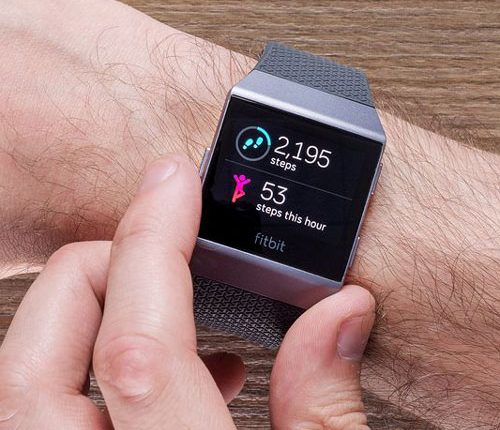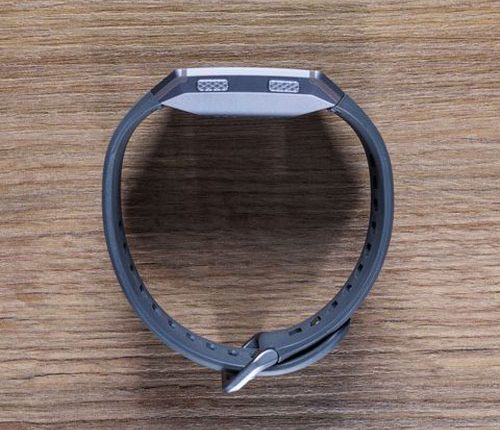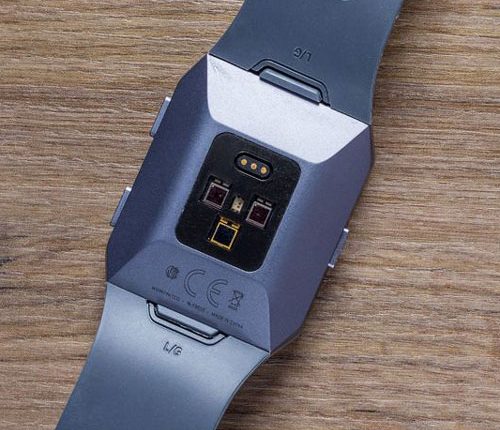It is official… Fitbit has announced it is entering the smartwatch business with the Fitbit Ionic.
While the company has dabbled in fitness-focused watches before with the Fitbit Blaze, the Ionic is the company’s first (and long-awaited) true smartwatch, distinguished by its support of third-party apps. But given how late to the game Fitbit is compared to its competitors, expectations are high. The game is on.
Examining the Iconic
First off, the hardware: the Ionic is built out of a lightweight aluminum case, broken up by iPhone-like antenna lines for the GPS, Bluetooth, and WiFi.
Fitbit says it has used a nano-molding technique to fuse plastic and metal together in the watch body. (This is a technique commonly used in smartphones, but not wearables.)
The case’s back is an angled, tapered design that’s meant to allow the various sensors on the back of the device to comfortably and accurately contact your wrist.
To the right side of the screen is a pair of buttons, with a third found to the left side of the display. The watch will come in silver, grey, and orange.
The display is a subtly curved spherical glass lens, although the bezels surrounding it are fairly large. Fitbit isn’t offering a lot of details on the screen’s exact specifications, but resolution was sharp and colors were vivid.
One spec it did mention was the brightness, which maxes out at 1000 nits to ensure that you’ll be able to see the screen even in direct sunlight.
When can we expect it?
The Ionic will cost $299.95 when it’s released sometime in October. That price will make it the most expensive Fitbit device yet, and also means Fitbit is commanding a higher price than the $269 Apple Watch Series 1. (Although, it’s cheaper than the Apple Watch Series 2.)
In many ways, the Ionic feels like an evolution of the existing Fitbit product lineup. At face value, you could call it an upgraded version of the Fitbit Blaze.
It offers a similar color touchscreen, notification support, and music control, but it has built-in GPS tracking, water resistance, swim tracking, and a third-party app platform that Fitbit insists will be ready for launch.
That’s really the thing that’s supposed to make the Ionic more than just an incremental upgrade over previous Fitbit devices.
The Ionic runs new software, Fitbit OS, which the company says will become the core of its current and future smartwatch endeavors.
Fitbit and Pebble
Fitbit OS will offer full support for third-party applications, with Fitbit drawing on the legacy of defunct smartwatch manufacturer Pebble, which it acquired last December.
Much like with Pebble OS, Fitbit applications will be relatively easy for developers to put together, with an SDK built on Javascript and SVG web standards.
Developers will have full access to all sensors on the device, including heart rate, GPS, accelerometer and more.
In addition to apps, users will also be able to install new third-party watchfaces through the Fitbit app, another aspect borrowed from Pebble. Apps for the Ionic will live in a new menu item called the Fitbit App Gallery.
It’ll be available at launch for select applications, with Fitbit giving some developers a few weeks to build apps before it’s opened to third parties. Additionally, there will be a couple of different ways for users to load applications and watchfaces to the Ionic.
Users will be able to side load content directly from private links, while those who want to share their apps on the App Gallery will need to go through the review process.
One of Fitbit’s native apps, FitStar (which it acquired in 2015) is now simply called Fitbit Coach; the company plans to roll out an audio service focused on running and walking programs, as well as a guided health program that will “expand dramatically” in the next year.
Partnering up
All of this is part of a larger effort to hook people into its software when the hardware itself is easy enough to ditch. But Fitbit is also partnering with four outside companies to get compelling apps pre-loaded onto the Ionic watch: Strava, Starbucks, Pandora, and Accuweather.
In particular, Pandora is an important partner, given that the Ionic offers 2.5GB of local storage for music – which is around 300 songs, or up to three Pandora playlists (if you’re a Plus member).
Pebble’s software isn’t the only acquired technology Fitbit is leveraging for the Ionic. The company is also introducing a new Fitbit Pay platform based on its acquisition of all-in-one credit card maker Coin, allowing for payments over NFC using the Ionic, even without a phone. Partners for Fitbit Pay will include a variety of major credit card companies, including AMEX, MasterCard, and Visa.
But Fitbit seems determined to really double down on fitness with this. Considering that most smartwatch makers haven’t been great with middling features, all while Apple was able to turn the Apple Watch a fitness watch, it’s a wise move by Fitbit.
Fitbit’s ‘PurePulse’ heart rate sensor has been upgraded, and the company says it now tracks heart rate more accurately for activities like running and cycling. A new tri-wave sensor on the bottom also tracks relative SpO2 (or oxygen saturation) to monitor oxygen levels in your blood, which the company plans to use for tracking new metrics in the future, including sleep apnea.
The Ionic also offers built-in GPS for tracking running or biking without requiring you to have your phone, and Fitbit claims the tracking on the Ionic is more accurate than on the Surge or any of its competitors.
There’s a new run detect system that can tell when you start and stop running and log that activity automatically. And the Ionic is capable of the same automatic sleep tracking as various other Fitbit devices, too.
How long will it last?
By now you’re probably wondering about battery life? This is where Fitbit is really trying to set itself apart: it’s claiming over four days of battery life for the Ionic, or up to ten hours while using the GPS – both of which would certainly be impressive, if it holds up in real world usage.
After The Verge tested out the Ionic over a few days, they believed that while the software isn’t quite finished yet, there were some mixed feelings about the device.
Purely as a fitness tracker, it’s certainly the best Fitbit ever used. Wearing it is comfortable, the battery life lasts multiple days, even with a few runs thrown in, and the software is clean and simple to use. But there are some misgivings about how well it will fare as a smartwatch.
Fitbit is entering the market relatively late compared to Apple and Google’s years-long head start, and both of those companies have a lot of third-party support and the major advantage of integrating deeply into their respective iOS and Android operating systems.
Take notifications, for example: the Fitbit can display these, but you can’t interact with in any real way.
And on the fitness front, Fitbit has to contend with companies like Garmin, which has created a profitable niche for itself in the wearables space.
There’s also the matter of hardware – the Ionic’s design is functional, but it clearly looks and feels like something designed for fitness first, and it maybe not be great to wear to a more formal event, unlike an Apple Watch or a dressier Android Wear device.
Like the Apple Watch, the Ionic uses a proprietary strap mechanism, so you’re stuck with whatever options Fitbit has to offer, which right now is a $29.95 sport band or a $59.95 leather option, on top of the $299.95 watch price.
That said, it’s still early days for the Ionic – it hasn’t even shipped yet.
Fitbit does have a strong following when it comes to hardware, and a good foundation for developer support in Pebble’s platform. Whether that will all come together is still to be determined.




Comments are closed, but trackbacks and pingbacks are open.